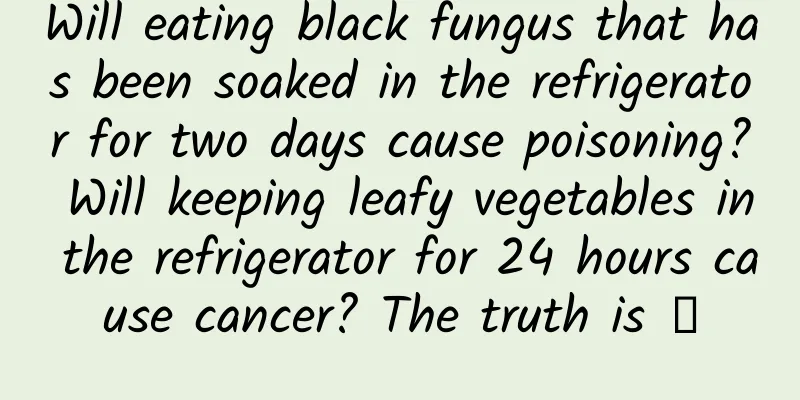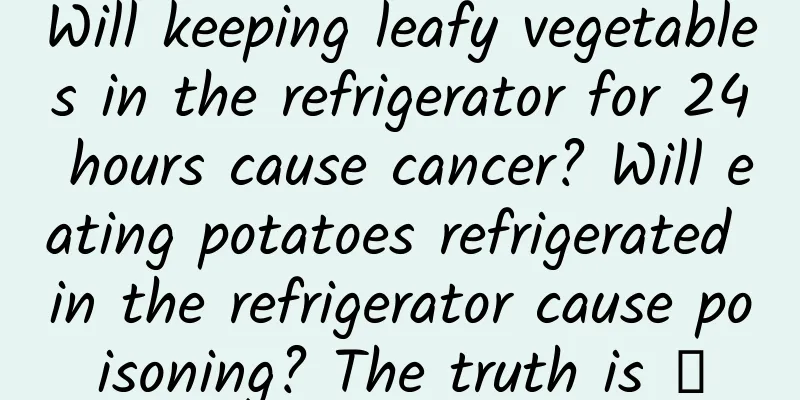Will eating black fungus that has been soaked in the refrigerator for two days cause poisoning? Will keeping leafy vegetables in the refrigerator for 24 hours cause cancer? The truth is →

|
The refrigerator is one of the greatest inventions in human history. Putting food with a short shelf life in it can not only preserve the freshness of the food, but also extend the consumption time to a certain extent. Recently, the author saw a video titled "Several Foods That Must Not Be Put in the Refrigerator". In the video, the host said: "Eating black fungus that has been soaked in the refrigerator for two days will cause poisoning", "When potatoes are put in the refrigerator, the starch is easily converted into polysaccharides under low temperatures, and some of these polysaccharides can cause poisoning", and "Leafy vegetables put in the refrigerator for 24 hours will produce a large amount of nitrite, which can cause cancer if eaten." In addition to the several refrigerator food storage rumors mentioned in the video, there are also widely circulated sayings on the Internet such as "Washing eggs and putting them in the refrigerator can extend the shelf life" and "Putting the fruits you bought in the refrigerator will prevent them from spoiling easily". So, are these sayings true or false? Let's analyze them in detail today. Video screenshots 01 Rumor: Eating black fungus that has been soaked in the refrigerator for two days will cause poisoning Analysis: False, this statement is too absolute. Soaking in the refrigerator for two days is not the root cause of fungus poisoning. In recent years, there have been occasional cases of poisoning from eating black fungus, the reason being improper soaking methods. When soaking black fungus, if the container is not clean, the room temperature is high, the soaking time is long, the water is turbid and the black fungus is sticky, if you eat it as usual, there will be a considerable risk of poisoning. The culprit for the poisoning is a toxin called fumonisin, which is a metabolite produced by the rampant growth of Pseudomonas cerebrovenenans. It is highly toxic and there is no specific cure. The average mortality rate of poisoning cases can be as high as over 50%. [1] It may be produced during the soaking process of black fungus, but it is most likely not produced during the soaking process in the refrigerator, but before it is put into the refrigerator, especially in the hot summer. This is because this fungus likes to grow at 37℃, the best temperature for toxin production is 26℃[2], and the temperature of the refrigerator is usually 0-4℃. The temperature is high in summer, so it is recommended to soak black fungus: ① Clean the surface of the fungus, use a clean container and water, and soak it in the refrigerator for about 3-4 hours. The fungus will be larger in size and have a more elastic taste. ② Soak as much as you want to eat, and eat it as soon as possible after soaking. Do not store it in the refrigerator for more than 24 hours after soaking. If you cannot finish it, it is recommended to pack it in fresh-keeping bags and store it in the freezer to minimize the risk. ③ During the soaking process, if you find that the surface is sticky, soft, or has an odor, discard it immediately. [3] 02 Myth: Potatoes are high in starch and produce polysaccharides in the low temperature environment of the refrigerator, some of which can cause food poisoning Analysis: Fake. Don't worry about it. Pay more attention to the sprouting potatoes. Under low-temperature storage conditions, potato starch will decompose and convert into sugar[4]. The so-called sugar is a normal "saccharification" phenomenon, which directly gives the taste a sweet taste, but it is not toxic. Instead of worrying about the impact of low-temperature storage, it is better to pay more attention to sprouted potatoes. Sprouted potatoes contain high levels of toxic alkaloids - solanine, which may cause poisoning if eaten by mistake. In fact, potatoes have a small amount of solanine in their "birthplace". This characteristic originates from their wild ancestors and is a self-protection mechanism to prevent them from being eaten by insects. However, the content of solanine in mature potatoes is extremely low and is not enough to cause harm to the human body. If potatoes are stored in a high temperature and sunny place, they will easily sprout or their skin will turn green. At this time, the solanine content in potatoes will greatly increase. Eating too much will easily turn them into "toxic" killers, causing symptoms such as vomiting, abdominal pain, and diarrhea. In theory, although heating and using vinegar can decompose solanine to a certain extent, there is no guarantee that it will be completely decomposed. To be on the safe side, it is recommended to throw it away directly. In addition, potatoes like low temperatures. If you want them to taste good and last longer, they should be kept at low temperatures and away from light, otherwise they will easily sprout and turn green. For potatoes bought in summer, it is recommended to put them in opaque bags, store them in the refrigerator, and eat them as soon as possible. Copyrighted stock images, no reproduction is authorized 03 Rumor: Leafy vegetables should not be kept in the refrigerator for more than 24 hours, otherwise they will easily produce a large amount of nitrite, which can cause cancer if eaten Analysis: False, too absolute. In fact, the nitrite produced by leafy vegetables at room temperature is higher than that of refrigerated vegetables. Leafy vegetables are indeed a category with a higher risk of nitrite, so it is reasonable to worry about it. This is mainly because leafy vegetables contain a certain amount of nitrate, which can easily be converted into nitrite to a certain extent; if excessive nitrite is consumed, it will be converted into nitrosamines in the body, which will increase the risk of cancer. The Hong Kong Food Safety Center has found that spinach, Chinese cabbage, and lettuce are three vegetables with high nitrate content, and they are also prone to produce high levels of nitrite during storage. [5] Take spinach, which easily accumulates nitrates, for example. If it is stored directly in a refrigerator at 4°C for no more than three days, the nitrite content will rise sharply from the third day. [6] In other words, it can be stored for three 24-hour periods. As for leftovers or overnight food, if the cooked vegetables are packaged while hot and quickly refrigerated, the risk of nitrite in "overnight food" can be ignored. Therefore, friends who bring lunch to work don't have to worry too much about this. The only thing to worry about is that it will be left at room temperature overnight, and it is not recommended to eat it the next day. The only vegetable that needs to be watched out for is spinach, because even if it is fried and refrigerated, after 16 hours, its nitrite content may exceed the national standard (the nitrite content in vegetable products should be less than 20 mg/kg). [7,8] Therefore, it is best to eat the spinach all at once. So, how to reduce the harm of nitrite in vegetables? ① Eat fresh leafy vegetables. ② Blanching leafy vegetables: Blanching in boiling water can remove most of the nitrate and nitrite components. ③ Eat immediately after cooking: Cook as much as you want to eat. If you cook too much, pack it in advance and refrigerate it immediately to reduce bacterial growth. It is not recommended to eat cooked food if it is left at room temperature for 2 hours or refrigerated for more than 24 hours. ④ Follow the principle of “try not to leave any leftovers and eat them up as soon as possible”. 04 Myth: Washing eggs before putting them in the refrigerator keeps them clean and prolongs their shelf life Analysis: False. Unfortunately, washing eggs in advance and refrigerating them may actually shorten their shelf life and contaminate kitchen utensils in the process. If you buy clean eggs with packaging, just store them in the refrigerator together with the packaging. If the loose eggs bought from the vegetable market are covered with chicken feathers and chicken droppings, many people can't help but wash them, but washing them will destroy the protective film of the eggshell itself. The egg shell has a layer of gelatinous film - "white frost", which not only covers the pores on the surface of the eggshell, but also resists the invasion of microorganisms such as bacteria, and prevents the evaporation of water inside the egg. Direct water washing will destroy the integrity of the gelatinous membrane, breaking the line of defense against external pollution. Microorganisms and other pathogens may directly enter the eggs through the pores and contaminate the eggs. In addition, the water content of the eggs will also be lost, and they will easily deteriorate over time. The correct way to do it is, if you can't finish the eggs you bought in a short time, it is best not to wash them with water first. If you are afraid of getting them dirty, you can "dry clean" them, such as wiping them with a dry cloth, dry sponge or paper towel, putting them in a plastic bag, sealing them and refrigerating them, and then wash them before eating. Copyrighted stock images, no reproduction is authorized 05 Rumor: Put all the fruits you buy in the refrigerator so they don’t spoil easily Analysis: False. Some fruits just don’t like to be in the refrigerator. You can’t put all the fruits you buy into the refrigerator at once. Not all fruits can be placed in the refrigerator. You need to analyze the specific situation. The refrigerator's refrigeration temperature is usually set at 4°C, which is good for keeping fresh. However, it is not a universal safe. Let's take a look at which fruits are not suitable for the refrigerator. Fruits that cannot be refrigerated before they are ripe: bananas, pineapples, avocados, passion fruit, mangoes, kiwis, and papayas.[9] These fruits need some time to ripen, and if they are not fully ripe, they are not suitable for refrigeration. At this time, they are very sensitive and delicate to low temperatures, and once they encounter low temperatures, they cannot ripen. Citrus fruits: These fruits also don’t like the refrigerator. Lemons, grapefruits, and oranges are prone to cold damage, so they can be stored directly at room temperature. Fruits like longan, pomegranate, and carambola can be kept for a long time at room temperature, but are more likely to suffer from cold damage if kept in the refrigerator. in conclusion The refrigerator is not a universal safe, and there are certain rules to follow when storing vegetables and fruits. In summer, it is recommended to soak black fungus in a clean container in the refrigerator. Eat it as soon as possible after soaking, and do not store it in the refrigerator for more than 24 hours; potatoes stored in the refrigerator at low temperature will not cause food poisoning; vegetables and fruits adhere to the "three current" principle of "eat now, buy now, and cook now", which can effectively avoid food safety risks. References: [1] Geng Xuefeng, Zhang Jing, Zhuang Zhong, et al. Epidemiological analysis of reported Pseudomonas cocovenenans food poisoning incidents in China from 2002 to 2016[J]. Journal of Health Research, 2020, 49(04): 648-650. DOI: 10.19813/j.cnki.weishengyanjiu.2020.04.024. [2] Chen Jia. Study on the mechanism of Pseudomonas cocovenenans poisoning and its preventive measures[J]. Modern Food, 2019(13):102-104.DOI:10.16736/j.cnki.cn41-1434/ts.2019.13.032. [3] The State Administration for Market Regulation issued consumer tips on how to prevent Pseudomonas cocovenenans food poisoning https://www.nmpa.gov.cn/yaowen/shchjgyw/20180905171301553.html [4] Yao Lixia. Effect of low temperature storage on sugar content of sweet potatoes, potatoes and processed products[D]. Zhejiang A&F University, 2019. [5] https://www.cfs.gov.hk/english/multimedia/multimedia_pub/multimedia_pub_fsf_172_01.html [6] Ma Xiaojun. Changes of nitrite content in spinach under different conditions [J]. Gansu Science and Technology, 2013, 29(15): 154-156. [7] Liu Juan, Gao Yifen, Yang Qian, et al. Preliminary study on the changes of nitrite content in overnight leafy vegetables [J]. Food Research and Development, 2016, 37(02): 150-153. [8] GB 2762-2022 National Food Safety Standard Limits of Contaminants in Food [9] Feng Shuangqing, ed. Storage and Transportation of Fruits and Vegetables (Second Edition) [M]. Beijing: Chemical Industry Press, 2008.3 Author: Wang Yanli, registered dietitian Review | Zhong Kai, Director of Kexin Food and Health Information Exchange Center The article is produced by "Science Refutes Facts" (ID: Science_Facts). Please indicate the source when reprinting. The cover image and images within this article are from the copyright gallery. Reprinting and quoting them may lead to copyright disputes. |
<<: Be careful if you have these items at home! They can cause serious injuries!
>>: A comprehensive review of the development of China's large aircraft
Recommend
Pickup Master TV: Chen Dali's "Live Game Master 2.0" full version
This course is "Live Game Master 2.0" b...
The flood peak broke the record of a century! "After the flood, we need to prevent a major epidemic"! After the flood, we must be vigilant in epidemic prevention
On June 22, the topic #YingdeFlood# ranked first ...
What are the reasons for the poor results of Baidu’s bidding promotion?
Customers often visit the official website to inq...
Don’t know how to do community operations? Try these 5 ideas for user operations
Community operation has been very popular recentl...
In-depth information | The most comprehensive guide to bidding OCPC advertising is online
Bidding OCPC is based on the long-term accumulati...
The Ministry of Industry and Information Technology will issue "22 regulations": APP rights requests should be based on the principle of minimum necessity
Mobile phone apps unscrupulously collect personal...
Spring Festival Marketing: Focus on Online, Breakthrough Offline
Despite the impact of the epidemic, the Spring Fe...
6 common mistakes made by smart people when it comes to data analysis!
6 common mistakes smart people make when it comes...
How did the “bare legs artifact” become a “beautiful torture device”?
Nude leggings have always been known as the "...
4 principles of a “next generation” brand
Today's technology is changing with each pass...
The two Microsofts: From being caught between a rock and a hard place to having the best of both worlds?
[[122625]] Editor's note: This article is mai...
European Automobile Manufacturers Association: European new car sales in November 2024 will be 1.06 million, a year-on-year decrease of 2%.
European car sales fell last month as slowing dem...
Haibei teachers help children learn (family education)
Introduction to Haibei teachers’ resources for he...
What are these stars "eating"? Hubble has the answer
The starry sky is mysterious, beautiful, and out ...
How do operators control user behavior?
It would be a great thing if we could get users t...






![[Smart Farmers] Debunking rumors: Will eating genetically modified foods change a person’s genes?](/upload/images/67f24631e1d92.webp)


